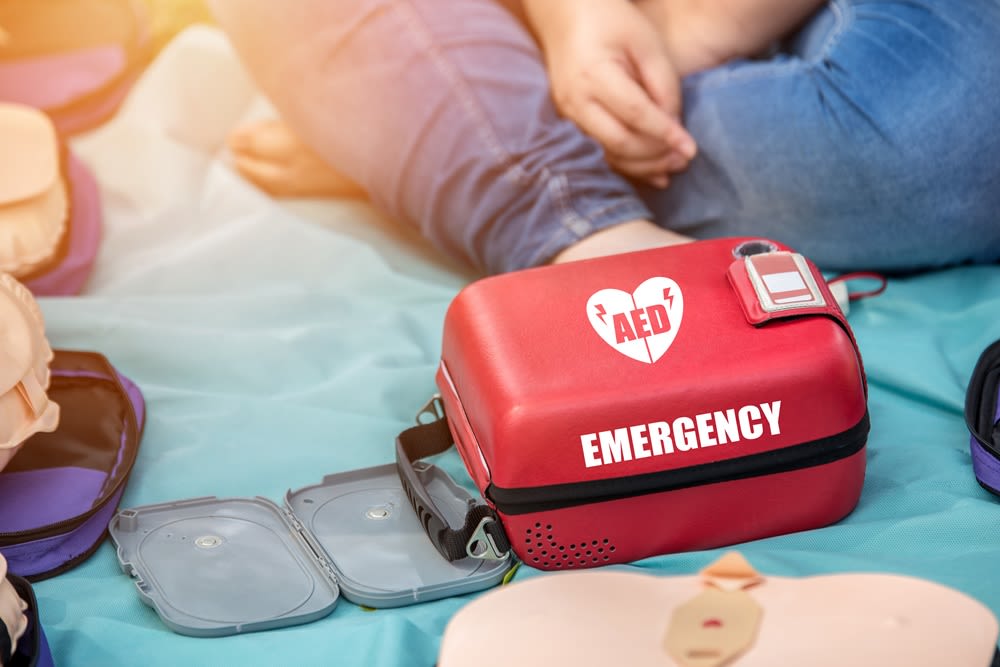
An automated external defibrillator (AED) is a small tool that delivers an electric shock that can restart the heart. The best AED for small businesses is one that is affordable, easy to use, and long-lasting.
Let’s dig deeper into the attributes of the best AED for small businesses like yours. With a bit of knowledge, you can make the right choice for your business.
What Is An AED?
An AED is a specialized medical device designed to help people deal with sudden cardiac arrest. As the U.S. Food and Drug Administration explains, these episodes are caused when the heart’s electrical system fails. The muscle begins to beat abnormally, and blood begins to pool.
During an episode like this, a shock delivered in the right place could help the electrical system to regain function. In a perfect scenario, an AED could save a person’s life within minutes.
10 Key Features of the Best AED for Small Business
Many different companies produce AEDs and sell them commercially. As a small business owner, you have plenty of options to choose from. Here’s what to look for as you shop.
1. Voice Guidance
Plenty of modern tools have vocal prompts. This makes it incredibly easy for people to use these devices correctly. In fact, experts suggest that voice technology is so common that it might be considered mandatory for all devices.
Some AEDs have spoken-word instructions for responders to follow. The best include prompts in multiple languages so more people can step in and help when needed.
2. Visual Aids
Researchers suggest that up to 65% of the population learns visually. These visual learners need clear illustrations to make sense of what to do next. Some AEDs combine their voice guidance with clear icons and infographics for visual learners to follow. The goal is to ensure as many people as possible use these devices appropriately.
3. Fast Function
The American Heart Association says that the chance of surviving a cardiac episode falls quickly for every minute that defibrillation is delayed. While having an AED is an important first step, you also need a device that works immediately. The perfect AED springs to life in seconds, with no need for a long warmup.
4. CPR Feedback
An AED provides a sharp, quick shock to a stopped heart. Often, that’s not quite enough. Researchers say the majority of people have no pulse for two minutes after the shock. Most need cardiopulmonary resuscitation (CPR) next. The right AED offers detailed verbal and visual instructions to ensure that responders provide this care properly.
5. Durability
AEDs should be built to last, but the safeguards can vary. The U.S. Food and Drug Administration provides AEDs with a rating about dust and solids. Higher numbers mean fewer particles get inside the machine to break it.
Many small business owners put their AEDs next to their OSHA first aid kits. However, some put them in wet or dusty locations, like warehouses or docks. Durability is especially important in these spaces. The devices should be built to last.
6. Self-Testing or Assessments
Most AEDs need replacement parts, such as new pads and batteries. Some also need repairs, especially after they’ve been used. The right AED will perform these checks regularly and notify you when a big step is required. This takes some of the guesswork out of maintenance.
7. Long Battery Life
Most AEDs are designed with portability in mind, and that means they need batteries. Ideally, the device has a long battery life, so it can be used multiple times without requiring a replacement part.
8. Connectivity
Researchers say that 47% of business traffic is via Wi-Fi. This stat means that most companies have and use robust Wi-Fi systems. Some AEDs have connectivity options, so you can check on the status of the device remotely without walking up to each one directly. The goal is to make maintenance as easy as possible, making it less likely to get skipped.
9. Low Upfront Cost
AEDs can range in price from $1,000 to about $2,500. The right AED for a business is affordable, especially if multiple devices are required to keep employees and visitors safe. If your business is multiple floors, you likely need an AED on each floor.
10. Low Maintenance Cost
All AEDs require some sort of maintenance and replacement parts. Ideally, those costs will be small enough that a business can cover them and ensure that the device remains in working condition when needed. If your AED isn’t in good condition when an emergency strikes, it defeats the purpose of having it in the first place.
Alsco Uniforms Health & Safety
Whether you need new AEDs for your business or want to replace those you already have, we here at Alsco Uniforms are ready to help. Our health and safety services ensure you always have the first aid kits and devices required by OSHA and desired by your staff. Contact us to find out more about how this works. We make the process easy for you.
References
How AEDs in Public Places Can Restart Hearts. (November 2022). U.S. Food and Drug Administration.
Voice Control Is Now Table Stakes for Consumer Electronics. (June 2021). Forbes.
Classification of Visual and Non-Visual Learners Using Electroencephalographic Alpha and Gamma Activities. (May 2019). Frontiers in Behavioral Neuroscience.
Your Onsite AED Program: An Implementation Guide. (2023). American Heart Association.
The Need to Resume Chest Compressions Immediately After Defibrillation Attempts. (April 2015). Resuscitation.
Share of Business Internet Traffic by Wi-Fi in the United States from 2016 to 2023. (January 2023). Statista.
Knowing Where an AED Is Located Can Save Time and Lives. (July 2023). Ohio State University.
Strategic Placement of Automated External Defibrillators (AEDs) for Cardiac Arrests in Public Locations and Private Residences. (April 2022). Resuscitation Plus.
